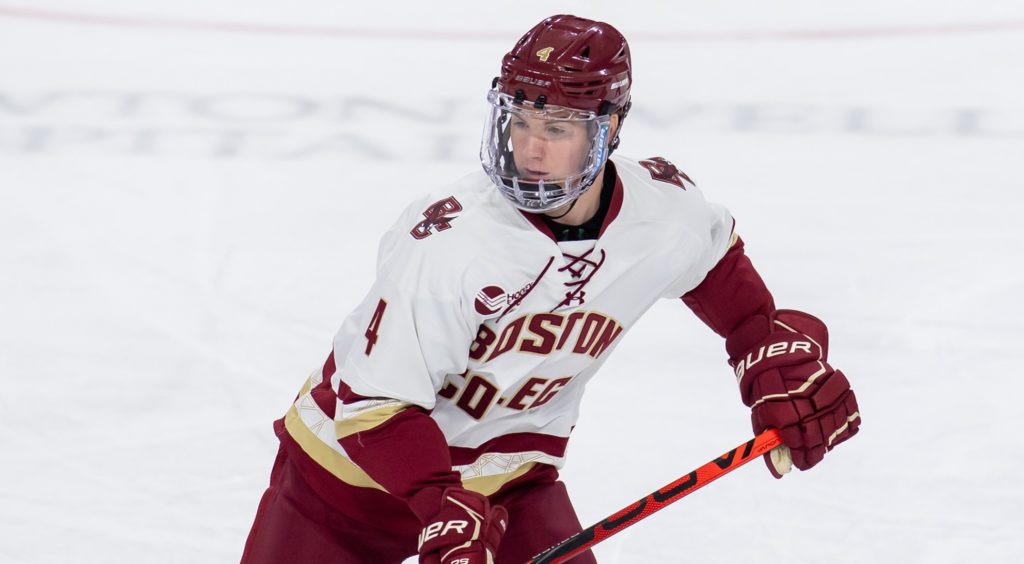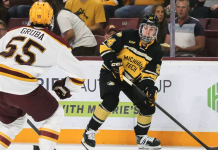
Each week during the season, we look at the big events and big games around Division I men’s college hockey in Tuesday Morning Quarterback.
Dan: For all of the TMQs (TMQses?) that I’ve been tasked with doing over the past year, I’ve really looked forward to the time that I could banter with Mr. Ed Trefzger. Not because of any other reason than because we’re cut from the same cloth of logging nights in some of those interesting buildings that dotted the northeastern United States.
Ed also holds a longtime notable moment for me when I went positively bananas during a hockey broadcast after about 17 Red Bulls during an Atlantic Hockey playoff series. To be fair, it was 10 years ago, and I’m way more mellow than I was back then, but I’ll always be grateful that both Ed and Chris Lerch helped bring me into USCHO a few years later.
Anyways, now that we’ve gotten this week’s session off to a roiling start, let’s see where we can take this thing…
…which is right back to Rochester, where Arizona State won two must-win games in its quest to qualify for the NCAA Tournament. Now at No. 22 in the PairWise Rankings, the 15-12 Sun Devils are pretty much playing must-win hockey the rest of the way, and with games against Alaska and LIU following Minnesota State (which is next weekend in Mankato), we have to assume that any loss to RIT would have ended the bid as it stands, correct?
Ed: I remember that night when I first encountered you, Dan, and I am delighted that you turned out not to be the … um … jerk I initially thought you were then, and that we’ve gotten to be good friends and USCHO colleagues!
Arizona State definitely needed to win those two games at RIT. After getting swept by Boston University the previous weekend, the Sun Devils stood at just 12-12. Adding the game against Northeastern on Tuesday – which was a complete win by an ASU team firing on all cylinders – and then getting the sweep against the Tigers has brought Greg Powers’ squad back from the brink.
However, there’s little room for error left the rest of the way. With eight games currently left on the schedule, the biggest challenge is going to be that pair of games at Minnesota State. I haven’t done the math or plugged the various scenarios into a simulator, but my hunch is that ASU needs to at least get a split against the Mavericks and then sweep both the home and road series with Alaska and the two against LIU to be in the running.
That would put Arizona State at 22-13. But because of the exemption for the two games in Fairbanks, the Sun Devils can add one more game to their schedule. If ASU can schedule a road game against a top team – perhaps to make up for a contest that another team has had canceled – it can conceivably improve that record to 23-13 and make it into the NCAA tournament.
The PairWise is a volatile measure with a lot of moving parts. We’ve written and spoken often at USCHO about how a league’s non-conference composite schedule is the major factor in how many at-large teams make it to the tournament. Quinnipiac, for example, is feeling the effects of ECAC Hockey’s .432 out-of-conference record, as the Bobcats are fifth in the PairWise as of this writing, mainly because of having the 35th ranked strength of schedule.
And that raises a question (or two): Is Quinnipiac overrated at No. 1 in this week’s DCU/USCHO Division I men’s ice hockey poll in light of the PairWise? Or is the PairWise a somewhat arbitrary measure that is more about meeting criteria than determining the better team at a given point in time?
Dan: There are a couple of different points in here worth breaking down, so I’ll take them both individually.
First, let’s start with Quinnipiac, which “won” the No. 1 spot when Minnesota State lost to Northern Michigan. It was an expected move, even if the Bobcats didn’t play, because it seems that a No. 1 team is always moved out of the spot if it loses. Whether or not that’s supposed to happen isn’t the debate, though, and I’ve admittedly been voting Quinnipiac as the No. 1 team for the better part of the last few weeks.
Here’s my reasoning. Quinnipiac is by far the best defensive team in the nation right now, and even a measured step backwards wouldn’t move the next team – also, ironically, Minnesota State – past it. The fact that the offense is a top-15 offense is, to me, a good enough way to extrapolate that the Bobcats would be a very good team even if you moved them out of ECAC, which is admittedly having a bad season for a number of reasons.
If you moved them around and compared them to the best teams in the country, how much would those numbers change? They shut out Northeastern and beat North Dakota, and they swept Arizona State with relative ease at home. In my mind, Quinnipiac has done everything possible to earn a No. 1 seed, and while I could spend 1,200 words explaining a more in-depth outline, I’ll leave it at that and further it by simply saying this team still has a long way to go to clinch a No. 1 seed.
That leads me to the second point, about the PairWise itself. I’m probably in the minority that doesn’t totally love the rankings as the sole method for determining the tournament field. I know using a selection committee last season wasn’t exactly a success, but I also believe that only using math is a bad way to determine which teams are better than others. If you look at the rankings right now, AIC is tied with Clarkson for 20th, Merrimack is 23rd, UConn is 24th, Harvard is 25th and Northern Michigan is 26th. Boston College is 30th.
Yet Harvard has a better winning percentage at 8-5-1 than all of those teams, and BC, at 10-8-3, is worse in the rankings than four teams with a worse overall record. What it tells me is that BC lost to the wrong teams while a team like AIC played well against the right teams. Harvard, by only having 14 games played, probably hasn’t played enough to really drill that point home.
Furthering that argument, if you look solely at the Hockey East clubs, Boston University and BC are both higher in the standings than Providence, Merrimack and UConn – all of which are better than both teams in the PairWise, with Providence sitting at 17th. So either everyone’s losing to the wrong teams or something’s a little broken by the numbers, and truthfully, that’s how I feel.
We know as much as anyone that AIC is pound-for-pound one of the toughest teams to beat in the nation, but if our Atlantic Hockey-leading Yellow Jackets slip against Holy Cross or Niagara or Mercyhurst or even RIT, then they’re going to tumble. And because Atlantic Hockey’s remaining games aren’t against many of those teams that are inside the right spots, there’s no opportunity for them to even move up.
That’s the point of the PairWise, I know, but it frustrates me because I think it prohibits teams from getting hot in the second half and proving they deserve a spot in the tournament. I respect the PairWise, but I think it should be used a guideline, not a be-all, end-all.
Moving beyond that, I actually wanted to bring up one other thing from this weekend that slipped through the cracks. Friday night marked the 365-day countdown for Sacred Heart to open the Martire Family Arena, its $70 million, on-campus arena. I’ve written at length about how this is going to change the game in college hockey, but even as the Pioneers battered Bentley on Friday, it wasn’t lost on me that we’re heading down to a new era.
We’ve spent a good amount of wording on facilities, enhancements, renovations and hockey-related development, but in your estimation, can you actually quantify how much that has changed since the old days of day-old pizza on a bus?
Ed: My goodness, things indeed have changed. When the MAAC was created, and then going into the early days of its successor Atlantic Hockey, the purpose of the conference was cost containment.
I remember riding the bus to do radio during RIT’s transition season to D-I and arriving at the Milford Ice Pavilion to play Sacred Heart and being stunned that the Pioneers were playing in a rather small youth hockey barn. Even so, community arenas like that, or AIC’s Olympia Ice Center, or the place you remember for so many great memories, the John A. Ryan Skating Arena that Bentley called home, helped get the league off the ground.
The expansion to 18 scholarships in Atlantic Hockey, and the move to better arenas and, better yet, beautiful on-campus facilities really means that the conference has left its budget-conscious past behind. But Atlantic Hockey has paved the way for the growth of D-I hockey and in its wake, maybe it’s time for another cost-containment league to be formed to help get more teams into the sport.
I agree with much of what you said about the PairWise. But I’m not ready to return to smoke-free smoke-filled rooms, either, even though the D-I committee did a really good job picking last year’s at-large teams.
I’m wondering how much the Olympics are going to affect this year’s NCAA tournament field. Many top programs will be without some of their best players in a key part of the season. I know you and Paula speculated about this in this column last week, but now that we know the Olympic roster, might we see a team bumped from the tournament due to a loss of talent or a shortened bench? And which teams are most vulnerable?
Dan: I had some genuine concerns for Minnesota and Michigan the more and more I read about the rumors surrounding both Team USA and Team Canada. It became obvious that both schools were going to lose highly-valued talents/prospects but bracing for that impact was a lot different than actually seeing it on paper.
I know the conversations internally had to be incredibly personal between players and coaches, and for some, it was probably an easy choice while others probably had to really think over if they wanted to leave college in the middle of a semester and a second half stretch run to go chase down a medal in Beijing. I don’t want to diminish that, and I respect the players, coaches and officials who I’m rooting incredibly hard for as an American…especially the fact that there are so many ties to Boston and Massachusetts.
But that, I can’t deny the impact this is going to have. Minnesota is kind of boom-or-bust right now and is already dealing with Jack LaFontaine’s rather rapid departure for the Carolina Hurricanes and the NHL (which, again, I think is a deeply personal decision). It’s sitting in 11th in the PairWise and slunk into third in the conference after stepping into nonconference play for two games against Alaska last weekend, and every week in the Big Ten is that kind of drama.
So when those players step away from their teams, there are going to be giant holes to fill, and at some point, not every team can fill each and every hole. Losing one or two players? I can live with that…you can treat that internally almost as if it’s an injury or something, but losing three? That’s going to be really hard to come back from, especially for a team teetering on the bubble.
I think Michigan will ultimately be fine because it has enough padding to absorb some of these blows, but we’re going to learn a lot about Minnesota over the next month. To his credit, Bob Motzko encouraged his players to go, and he wanted them to enjoy a once-in-a-lifetime opportunity. He understands it, he gets it, and he’s going to be prepared to do whatever it takes to get the Gophers over the hump and keep that machine running. But as someone on the outside, I’m interested to see how it plays out.
I look forward, in all honesty, to Minnesota winning the Big Ten and ramming this entire piece right back in my face when we all meet in Boston for the Frozen Four…because that’s the karma I’m probably throwing into the world right now.
I’m interested to see the impact on teams like Boston College and Harvard as well since each are losing a couple of players, including some big names like Marc McLaughlin and Drew Helleson from BC, at a time when they need to start winning games with some urgency in the PairWise.
What’s your outlook on that, Ed? And does having the NCAA component make you more inclined to be up in the wee hours to watch the Americans win gold in Beijing (calling my shot now)?
Ed: I miss the days of amateurs in the Olympics. In 1980, the TV in the lounge on my floor in the dormitory was stolen just before Lake Placid, and more than a dozen guys crammed into my tiny room to watch USA win gold on my roommate’s tiny black-and-white set. The win led to a spontaneous and huge pep rally on campus in one of the quads and chants of “U.S.A. U.S.A.”
The series of malaise-era video clips at the start of the movie Miracle? That’s accurate. Having endured Watergate, the Iran hostage crisis, the energy crisis, and everything else dreary about the seventies, that gold medal was cathartic for a nation. Even for 18-year-old college students like me.
That’s my long-winded way of saying, “Yes!”
I can’t wait to watch. Even in the wee hours.
A chance to compete for your country doesn’t come along very often, and I’m excited for the 15 current college players and the 10 NCAA alums who will compete for the red, white, and blue.


